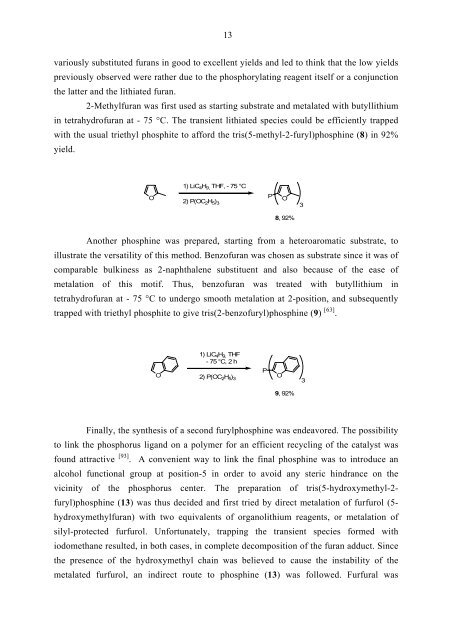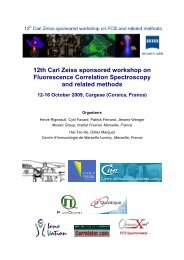My PhD dissertation - Institut Fresnel
My PhD dissertation - Institut Fresnel
My PhD dissertation - Institut Fresnel
You also want an ePaper? Increase the reach of your titles
YUMPU automatically turns print PDFs into web optimized ePapers that Google loves.
13<br />
variously substituted furans in good to excellent yields and led to think that the low yields<br />
previously observed were rather due to the phosphorylating reagent itself or a conjunction<br />
the latter and the lithiated furan.<br />
2-Methylfuran was first used as starting substrate and metalated with butyllithium<br />
in tetrahydrofuran at - 75 °C. The transient lithiated species could be efficiently trapped<br />
with the usual triethyl phosphite to afford the tris(5-methyl-2-furyl)phosphine (8) in 92%<br />
yield.<br />
O<br />
1) LiC 4H9, THF, - 75 °C<br />
2) P(OC 2H 5) 3<br />
P<br />
O<br />
8, 92%<br />
Another phosphine was prepared, starting from a heteroaromatic substrate, to<br />
illustrate the versatility of this method. Benzofuran was chosen as substrate since it was of<br />
comparable bulkiness as 2-naphthalene substituent and also because of the ease of<br />
metalation of this motif. Thus, benzofuran was treated with butyllithium in<br />
tetrahydrofuran at - 75 °C to undergo smooth metalation at 2-position, and subsequently<br />
trapped with triethyl phosphite to give tris(2-benzofuryl)phosphine (9) [63] .<br />
O<br />
1) LiC 4H 9, THF<br />
- 75 °C, 2 h<br />
2) P(OC 2H 5) 3<br />
P<br />
O<br />
9, 92%<br />
Finally, the synthesis of a second furylphosphine was endeavored. The possibility<br />
to link the phosphorus ligand on a polymer for an efficient recycling of the catalyst was<br />
found attractive<br />
[ ] 93 . A convenient way to link the final phosphine was to introduce an<br />
alcohol functional group at position-5 in order to avoid any steric hindrance on the<br />
vicinity of the phosphorus center. The preparation of tris(5-hydroxymethyl-2-<br />
furyl)phosphine (13) was thus decided and first tried by direct metalation of furfurol (5-<br />
hydroxymethylfuran) with two equivalents of organolithium reagents, or metalation of<br />
silyl-protected furfurol. Unfortunately, trapping the transient species formed with<br />
iodomethane resulted, in both cases, in complete decomposition of the furan adduct. Since<br />
the presence of the hydroxymethyl chain was believed to cause the instability of the<br />
metalated furfurol, an indirect route to phosphine (13) was followed. Furfural was<br />
3<br />
3













